
Videos
Regulating Social Media: America’s Global Communications Dilemma
Reports & Papers
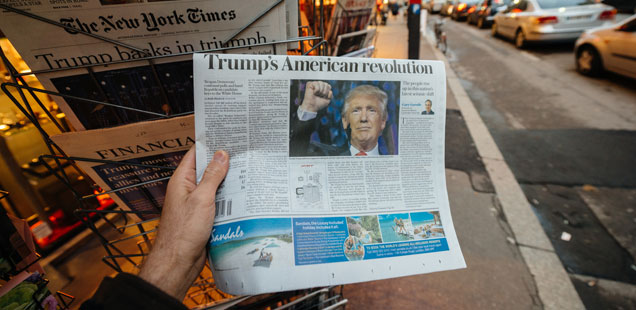
A new report from Harvard Kennedy School’s Shorenstein Center on Media, Politics and Public Policy analyzes news coverage during the 2016 general election, and concludes that both Hillary Clinton and Donald Trump received coverage that was overwhelmingly negative in tone and extremely light on policy.
The negativity was not unique to the 2016 election cycle but instead part of a pattern in place since the 1980s and one that is not limited to election coverage. “A healthy dose of negativity is unquestionably a good thing,” writes Thomas Patterson, the study’s author. “Yet an incessant stream of criticism has a corrosive effect. It needlessly erodes trust in political leaders and institutions and undermines confidence in government and policy,” resulting in a media environment full of false equivalencies that can mislead voters about the choices they face.
The study found that, on topics relating to the candidates’ fitness for office, Clinton and Trump’s coverage was virtually identical in terms of its negative tone. “Were the allegations surrounding Clinton of the same order of magnitude as those surrounding Trump?” asks Patterson. “It’s a question that political reporters made no serious effort to answer during the 2016 campaign.”
This is the final report of a multi-part research series analyzing news coverage of candidates and issues during the 2016 presidential election. The study tracks news coverage from the second week of August 2016 to the day before Election Day.
This Shorenstein Center study is based on an analysis of news reports by ABC, CBS, CNN, Fox, the Los Angeles Times, NBC, The New York Times, USA Today, The Wall Street Journal, and The Washington Post. The study’s data were provided by Media Tenor, a firm that specializes in the content analysis of news coverage. The research was partially funded by the John S. and James L. Knight Foundation.
Criticism dogged Hillary Clinton at every step of the general election. Her “bad press” outpaced her “good press” by 64 percent to 36 percent. She was criticized for everything from her speaking style to her use of emails.
As Clinton was being attacked in the press, Donald Trump was attacking the press, claiming that it was trying to “rig” the election in her favor. If that’s true, journalists had a peculiar way of going about it. Trump’s coverage during the general election was more negative than Clinton’s, running 77 percent negative to 23 percent positive. But over the full course of the election, it was Clinton, not Trump, who was more often the target of negative coverage (see Figure 1). Overall, the coverage of her candidacy was 62 percent negative to 38 percent positive, while his coverage was 56 percent negative to 44 percent positive.
Figure 1. Tone of Nominees’ Coverage
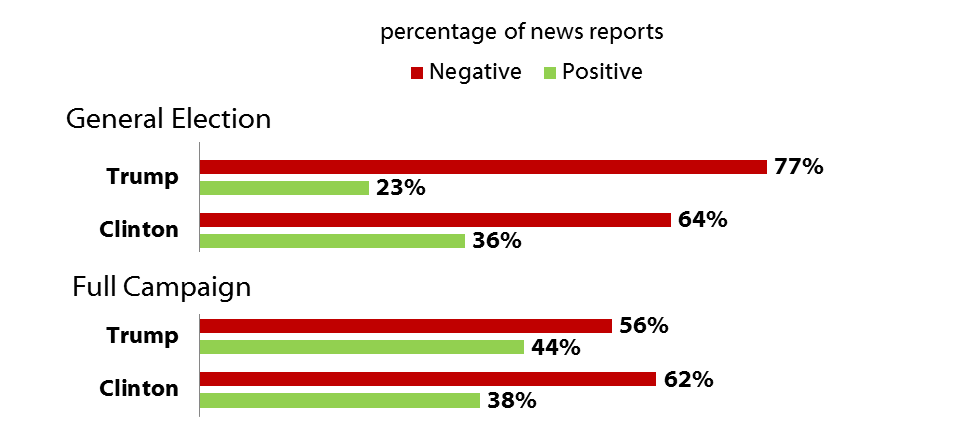
Negative coverage was the order of the day in the general election. Not a week passed where the nominees’ coverage reached into positive territory. It peaked at 81 percent negative in mid-October, but there was not a single week where it dropped below 64 percent negative.
Even those numbers understate the level of negativity. Much of the candidates’ “good press” was in the context of the horserace—who is winning and who is losing and why. At any given moment in the campaign, one of the candidates has the momentum, which is a source of positive coverage. Figure 2 shows the tone of the nominees’ coverage on non-horserace topics, those that bear some relationship to the question of their fitness for office—their policy positions, personal qualities, leadership abilities, ethical standards, and the like. In Trump’s case, this coverage was 87 percent negative to 13 percent positive. Clinton’s ratio was identical—87 percent negative to 13 percent positive. “Just like Tweedledum and Tweedledee,” as Barry Goldwater said dismissively of America’s two parties in the 1960s.
Figure 2. Tone of Nominees’ Coverage on Topics Relating to Their “Fitness” for Office
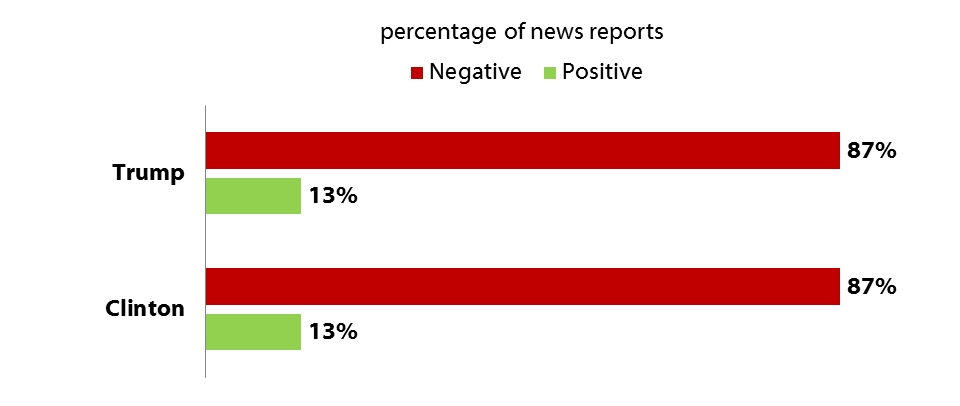
As journalists would have it, the Trump and Clinton camps were the cause of all the negativity. And it was certainly true that the election was unusually nasty. But to attribute the tone entirely to the opposing camps is to ignore the pattern of presidential election coverage during the past few decades (see Figure 3). Not since 1984—eight elections ago—have the presidential nominees enjoyed positive press coverage. The 2016 campaign did not even top the record for negativity. That distinction belongs to the 2000 campaign when news reports questioned whether Al Gore was trustworthy enough and George W. Bush was smart enough to deserve the presidency.[1]
Figure 3. Tone of Presidential Nominees’ Coverage, 1960-2016
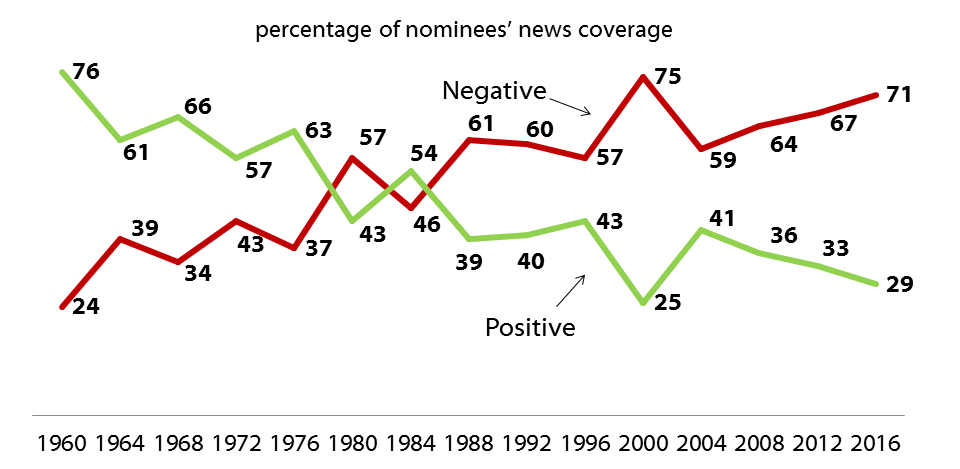
The press’s negative bent is not confined to election politics (see Figure 4).[2] In recent years, when immigration has been the subject of news stories, the ratio of negative stories to positive ones has been 5-to-1. In that same period, news reports featuring Muslims have been 6-to-1 negative. News stories about health care policy, most of which centered on the 2010 Affordable Care Act, have been 2-to-1 negative. Although the nation’s economy has steadily improved since the financial crisis of 2008, one would not know that from the tone of news coverage. Since 2010, news stories about the nation’s economy have been 2-to-1 negative over positive.
Figure 4. Tone of Coverage of Selected Topics, 2010-2016
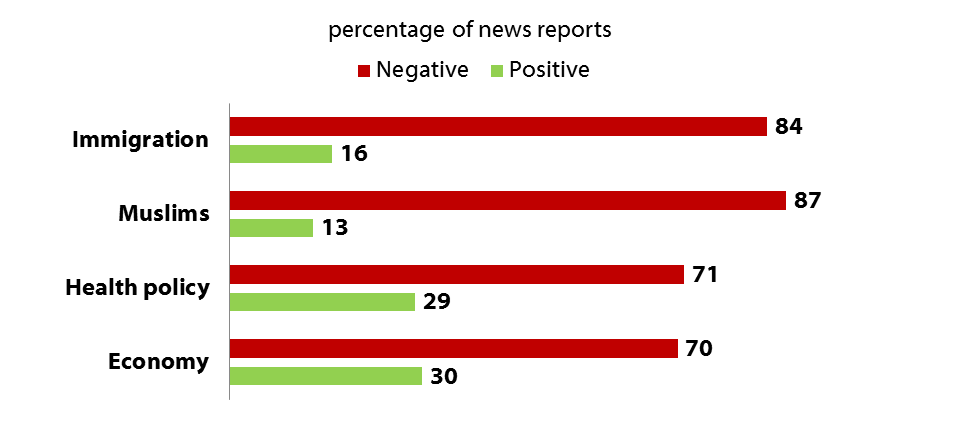
The car wreck that was the 2016 election had many drivers. Journalists were not alone in the car, but their fingerprints were all over the wheel.
The real bias of the press is not that it’s liberal. Its bias is a decided preference for the negative. As scholar Michael Robinson noted, the news media seem to have taken some motherly advice and turned it upside down. “If you don’t have anything bad to say about someone, don’t say anything at all.”[3] A New York Times columnist recently asserted that “the internet is distorting our collective grasp on the truth.”[4] There’s a degree of accuracy in that claim but the problem goes beyond the internet and the talk shows. The mainstream press highlights what’s wrong with politics without also telling us what’s right.
It’s a version of politics that rewards a particular brand of politics. When everything and everybody is portrayed as deeply flawed, there’s no sense making distinctions on that score, which works to the advantage of those who are more deeply flawed. Civility and sound proposals are no longer the stuff of headlines, which instead give voice to those who are skilled in the art of destruction. The car wreck that was the 2016 election had many drivers. Journalists were not alone in the car, but their fingerprints were all over the wheel.
This report is the fourth in our series of reports on media coverage of the 2016 presidential election. The first examined news coverage during 2015—the so-called “invisible primary” stage of the campaign.[5] The second study focused on news coverage of the presidential primaries and caucuses.[6] The third study spanned the four-week period of the national party conventions, from a week before the first of the back-to-back conventions to a week after the second.[7] This fourth study picks up where the third study left off, beginning the second week of August and ending the day before the November balloting.
The research is confined to the election coverage in the print editions of five daily papers (the Los Angeles Times, The New York Times, The Wall Street Journal, The Washington Post, and USA Today) and the main newscasts of five television networks (ABC World News Tonight, CBS Evening News, CNN’s The Situation Room, Fox’s Special Report, and NBC Nightly News). In the case of the newspapers, the analysis covers all sections except sports, obituaries, and letters to the editor. Op-eds and editorials are included, but letters from the public are not. For television, the analysis covers the full daily content of each network’s major newscast. Network talk shows are not included.
The data for our studies are provided by Media Tenor, a firm that specializes in collecting and coding news content. Media Tenor’s coding of print and television news stories is conducted by trained full-time employees who visually evaluate the content. Coding of individual actors (e.g., presidential candidates) is done on a comprehensive basis, capturing all reports of more than five lines (print) or five seconds (TV) of coverage for a given actor. For each report, coders identify relevant themes (topics) and actors and evaluate the tone (positive or negative) on a six-point scale. These tonality ratings are then combined to classify each report for each actor as being negative, positive, or having no clear tone. The percentages presented in this paper are the combined averages for the ten news outlets.[8]
Nearly half a million people turned out on Labor Day in Detroit in 1936 to see and hear presidential candidate Franklin Roosevelt. The crowd was so deep that it extended like fingers into the streets, spreading out from Cadillac Square.[9]
As political scientist Bernard Cohen put it, the press “may not be successful much of the time in telling people what to think, but it is stunningly successful in telling them what to think about.”
Labor Day was once a highlight of the general election—the informal kickoff to the fall campaign. Today, the general election is merely a continuation of a campaign that begins in earnest more than a year earlier. Nevertheless, for some voters, the general election is a time to pay closer attention. The 2016 primary election debates had record audiences. Yet those debates drew on average fewer than a fourth as many viewers as did each of the three general election presidential debates.[10]
Like the earlier stages of the campaign, the general election is a secondhand event for most Americans. They don’t take the time—most don’t have the opportunity—to see the candidates firsthand. They look instead to the media to learn about the campaign. To be sure, they are not hapless recipients of the media’s messages. Rock-ribbed Republicans and diehard Democrats can see the same story and draw radically different conclusions. Nevertheless, the news media have what journalist Theodore H. White called “a primordial power”—the power to direct our attention.[11] As political scientist Bernard Cohen put it, the press “may not be successful much of the time in telling people what to think, but it is stunningly successful in telling them what to think about.”[12]
What was the media agenda during the 2016 general election? What aspects of the campaign were put on public display? What aspects received only slight attention?
During the early stages of the 2016 presidential campaign, Donald Trump was the center of press attention. Each month from the time he announced his candidacy until he received his party’s presidential nomination, he was the most heavily covered candidate. It wasn’t even close. During that period, Trump received 63 percent of the coverage compared to 37 percent for his most heavily covered rival.
When asked to explain their focus on Trump, journalists say that he made himself readily available to the press. But availability has never been the standard of candidate coverage. If that were so, third-party candidates and also-rans would dominate coverage.
The general election period continued the pattern (see Figure 5). Week after week, Trump got more press attention than did Clinton. Overall, Trump received 15 percent more coverage than she did. Trump also had more opportunities to define Clinton than she had to define him. When a candidate was seen in the news talking about Clinton, the voice was typically Trump’s and not hers. Yet when the talk was about Trump, he was again more likely to be the voice behind the message. “Lock her up” and “make America great again” were heard more often in the news than “he’s unqualified” and “stronger together.”
When asked to explain their focus on Trump, journalists say that he made himself readily available to the press.[13] But availability has never been the standard of candidate coverage. If that were so, third-party candidates and also-rans would dominate coverage. They hunger for news exposure. Trump’s dominant presence in the news stemmed from the fact that his words and actions were ideally suited to journalists’ story needs. The news is not about what’s ordinary or expected. It’s about what’s new and different, better yet when laced with conflict and outrage. Trump delivered that type of material by the cart load. Both nominees tweeted heavily during the campaign but journalists monitored his tweets more closely. Both nominees delivered speech after speech on the campaign trail but journalists followed his speeches more intently. Trump met journalists’ story needs as no other presidential nominee in modern times.
Figure 5. Nominees’ Coverage, by Week
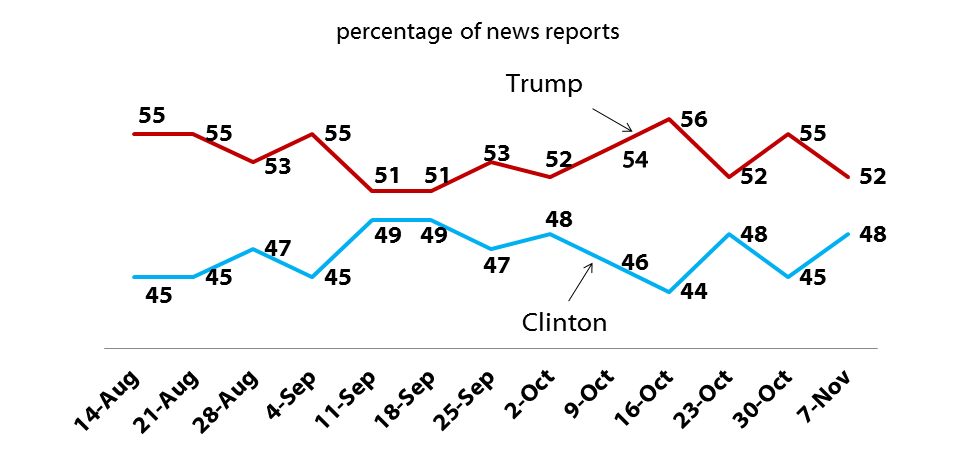
As in other recent campaigns, the media’s coverage focused on the horserace—the question of who is winning and who is losing, and by what margin and why (see Figure 6).[14] The horserace has been the dominant theme of election news since the 1970s, when news organizations began to conduct their own election polls.[15] Since then, polls have proliferated to the point where well over a hundred separate polls—more than a new poll each day—were reported in major news outlets during the 2016 general election.
Figure 6. Campaign Coverage by Topic
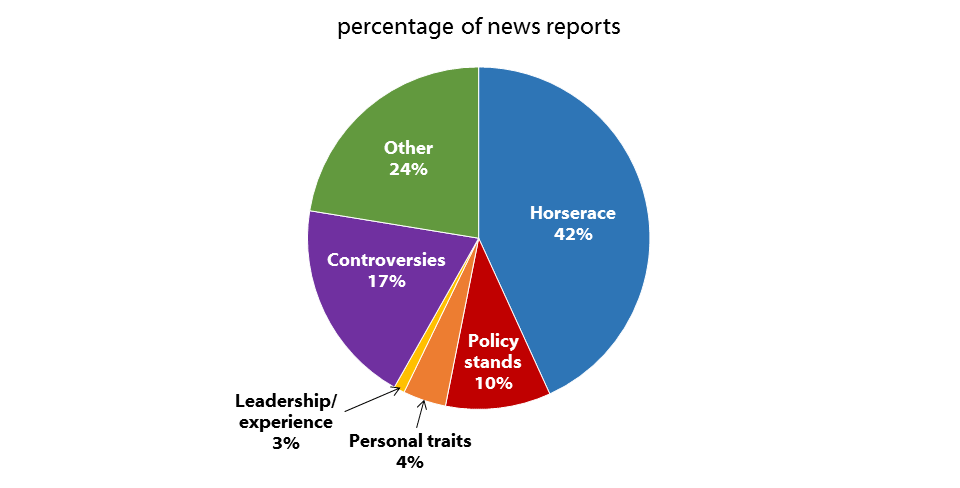
Journalists’ fondness for polls is no great mystery. Polls are a snap to report and provide a constant source of fresh material. Their influence on election news goes beyond the stories that describe the latest poll results. Poll results increasingly frame the content of other stories, as journalists use them to explain shifts in candidate strategy or the impact of the latest development. When the FBI director announced nine days out from the election that a new batch of Clinton emails had been found, the major story line was the likely impact of the revelation on Clinton’s standing in the polls, which was followed in subsequent days by reports of new polls showing that her support was slipping.
Policy issues—what the nominees would do if elected—rarely attract a high level of press coverage, and the 2016 election was no exception. Although candidates in their stump speeches focus on the policies they would pursue as president, their stands do not receive close attention from journalists. In the 2016 general election, policy issues accounted for 10 percent of the news coverage—less than a fourth the space given to the horserace. Policies lack the novelty that journalists seek in their stories. A new development may thrust a new issue into the campaign, but policy problems are typically longstanding. If they came and went overnight, they would not be problems. Thus it is that when a candidate first announces a policy stand, it makes news. Later on, it’s old news and likely to make headlines only if it has a new wrinkle.[16]
Although candidates in their stump speeches focus on the policies they would pursue as president, their stands do not receive close attention from journalists.
To journalists, the real issues of presidential politics are not the candidates’ policy commitments but instead the controversies that ensnare them. The 2016 campaign fit the pattern to a tee. Everything from Clinton’s emails to Trump’s taxes was grist for the media mill. They accounted for 17 percent of the coverage—one in every six news reports.
Controversies have been a staple of election coverage since at least 1976 when Democratic nominee Jimmy Carter said in a Playboy interview that he had “looked at a lot of women with lust.”[17] Some of these controversies have had a bearing on the type of president a candidate might make, but many, as with Carter’s Playboy interview, have had no apparent connection. In any case, their relationship to the question of who would make the better president is not what makes them newsworthy. They make news because they’re an abrupt break in the routine, and could affect a candidate’s chances of winning. “It has become a spectacle like no other in modern American politics,” political scientist Larry Sabato observed. “The news media, print and broadcast, go after a wounded politician like sharks in a feeding frenzy. The wounds may have been self-inflicted, and the politician may richly deserve his or her fate, but the journalists now take center stage in the process, creating the news as much as reporting it.”[18]
Controversies are a candidate’s nightmare. Opponents and journalists alike have a stake in keeping a controversy alive, so the candidate’s only hope is that the revelation is small enough or transient enough to die down on its own. When it’s in the news, there’s no upside for the candidate. During the 2016 general election, more than 90 percent of the news coverage of controversies was negative in tone (see Figure 7).
Figure 7. Tone of Campaign Coverage, by Topic
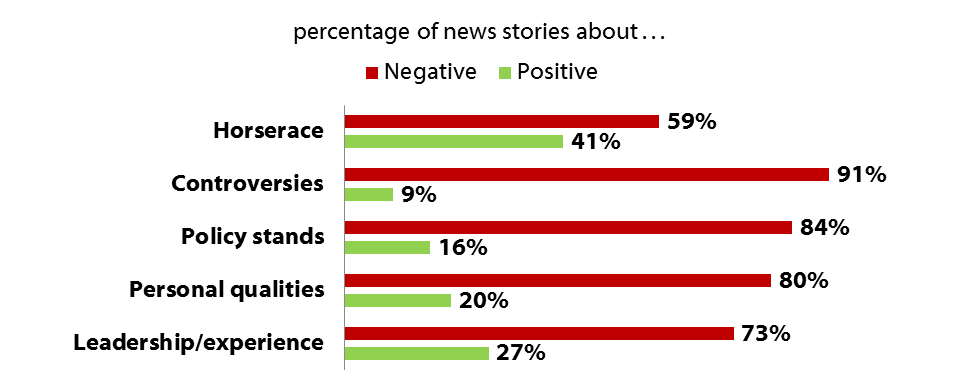
Although controversies drew the highest percentage of negative coverage in 2016, other aspects of the campaign weren’t far behind. The candidates’ policy positions drew heavy criticism—84 percent negative to 16 percent positive. So did the candidates’ personal qualities—80 percent negative to 20 percent positive. Reports touching on the candidates’ leadership and experience were less negative but only in relative terms. They ran nearly 3-to-1 negative—73 percent to 27 percent.
The horserace coverage was the most positive area of coverage, though it too was negative on balance—59 percent negative to 41 percent positive. Both candidates can’t lose, so the horserace is a source of positive coverage for whichever candidate is trending upward in the polls. On the other hand, journalists give more play to losing than to winning, so horserace coverage tilts toward the negative. That pattern has been found to apply also to presidential approval ratings. When a president’s poll rating is slipping, it gets more news coverage than when it’s rising.[19]
Trump’s general election news coverage fit the pattern of earlier stages of the campaign in several respects but not all. The major departure was that his general election coverage was overwhelmingly negative in tone. In our earlier reports, we documented the positive coverage Trump received during the nominating stage of the campaign, a pattern largely attributable to the press’s tendency to highlight the horserace in the pre-primary and primary periods. As Trump rose from single digits in the polls and then won key primaries, he got favorable press. It was a story of growing momentum, rising poll numbers, ever larger crowds, and electoral success. The fact that the horse race is the most heavily covered aspect of the nominating phase magnified Trump’s favorable coverage.
Trump’s general election coverage was a stark contrast. His coverage was negative from the start, and never came close to entering positive territory (see Figure 8). During his best weeks, the coverage ran 2-to-1 negative over positive. In his worst weeks, the ratio was more than 10-to-1. If there was a silver lining for Trump, it was that his two best weeks were the ones just preceding the November balloting.
Figure 8. Tone of Trump’s Coverage, by Week
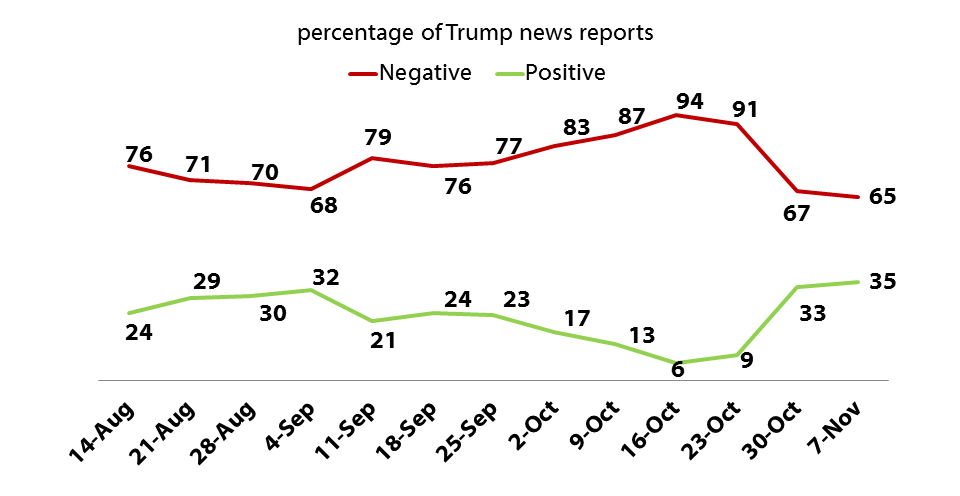
Trump’s coverage was negative in all the news outlets in our study, even those that typically side with the Republican nominee (see Figure 9). Fox provided Trump his most favorable coverage, but it was still nearly 3-to-1 negative over positive. The Wall Street Journal was his next best outlet, but its coverage ran 4-to-1 negative. The most negative coverage was carried by CBS at 9-to-1, but Trump’s coverage was nearly as negative in most other outlets.
Figure 9. Tone of Trump’s Coverage, by News Outlet
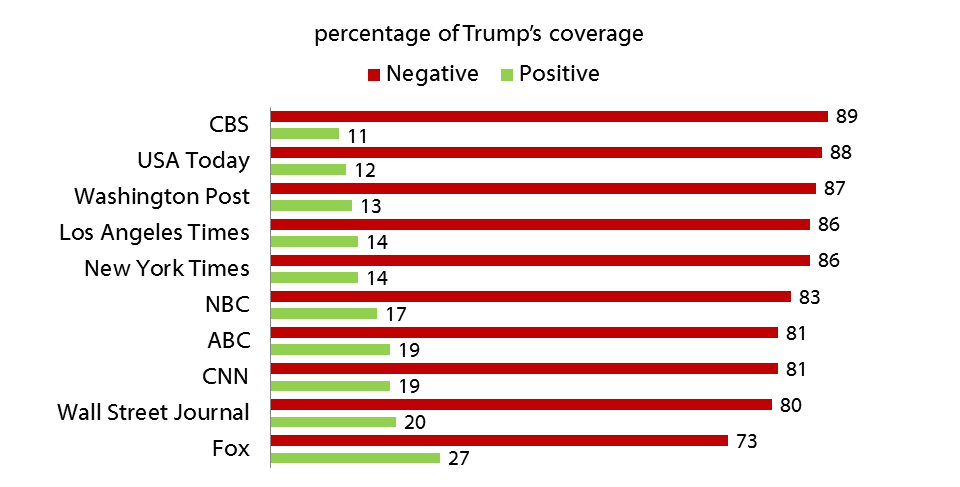
Trump’s coverage differed from that of most recent nominees in one respect. His policy stands got more press attention than is usually the case.[20] They took up 12 percent of his coverage (see Figure 10). Trump’s way of talking about the issues was the reason they captured journalists’ attention. Although his stand on undocumented immigrants was not all that different in its provisions than that of several other Republican contenders, including Ted Cruz, Trump’s words made it newsworthy. Immigrants were “rapists,” “murderers,” “terrorists.”
Figure 10. Topics of Trump’s Coverage
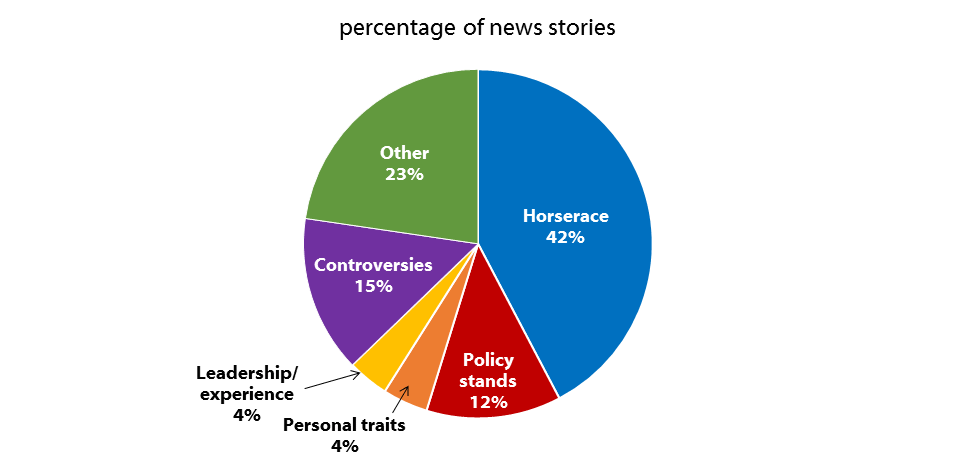
At that, Trump’s policy issues got less coverage during the general election than did a series of controversies that began with his attack on the Gold Star parents Khizr and Ghazala Khan after they had criticized him in a speech at the Democratic convention. That was followed by controversies involving the Trump Foundation, his refusal to release his tax returns, his avoidance of paying federal taxes, his allegation that the system was rigged against him, and his refusal (“unless I win”) to say that he would accept the election outcome. Trump’s most heavily covered controversy was triggered by the release of a video that captured him on microphone bragging about groping women without their consent, saying that “when you’re a star, they let you do it.” It was made public in early October, driving Trump’s negative coverage from the 70-percent range into the 90-percent range.
Controversies accounted for 15 percent of Trump’s coverage. On the other hand, his leadership ability and experience were infrequently touched upon in the general election, accounting for 4 percent of his coverage. His personal traits, such as his relationship with business associates, also accounted for 4 percent.
No aspect of Trump’s coverage was positive in tone (see Figure 11). His horserace coverage, which had given him a boost when facing Republican opponents, ran 78 percent negative to 22 percent positive. He trailed Clinton in the polls at virtually every stage of the general election, which, in the press’s horserace narrative, made him a “likely loser,” which is a negative story.
Figure 11. Tone of Trump’s Coverage, by Topic
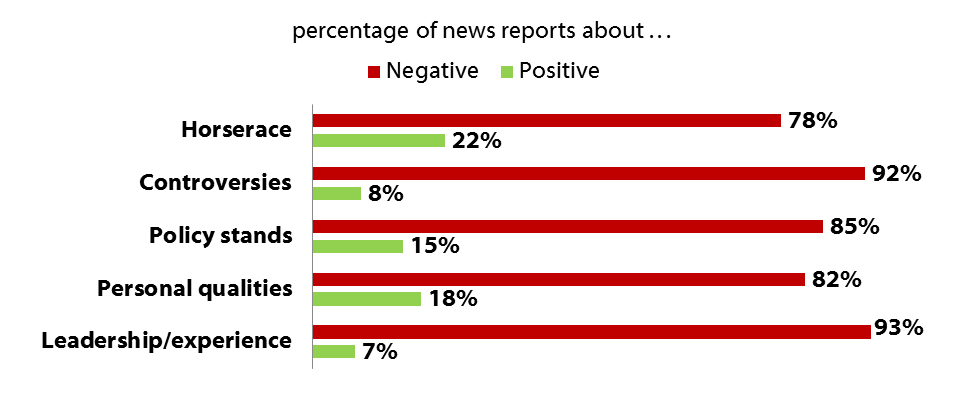
The other areas of Trump’s coverage were even more negative. News reports focusing on his personal qualities were 82 percent negative to 18 percent positive. His policy stands were widely criticized—coverage in that area was 85 percent negative to 15 percent positive. His leadership qualities and experience were treated even more harshly—93 percent negative to 7 percent positive. The controversies enveloping his candidacy were also a source of bad news. Collectively, they ran 92 percent negative to 8 percent positive—a ratio of 11-to-1.
Like Trump, Clinton’s coverage was negative in tone. Unlike Trump, it was a continuation of a pattern that had been set at the start of her presidential run. In the nineteen months leading up to the general election, there were only two months where Clinton’s coverage was positive on balance, and then by less than 5 percentage points in each case. The general election campaign continued the string. Her coverage in every month—August, September, October, and early November—was negative on balance. During the entire general election, there was only a single week where the balance was positive (see Figure 12). That week was the one following the first debate, where her strong performance pushed her into positive territory for the week, though by the slim margin of 4 percentage points.
Figure 12. Tone of Clinton’s Coverage, by Week
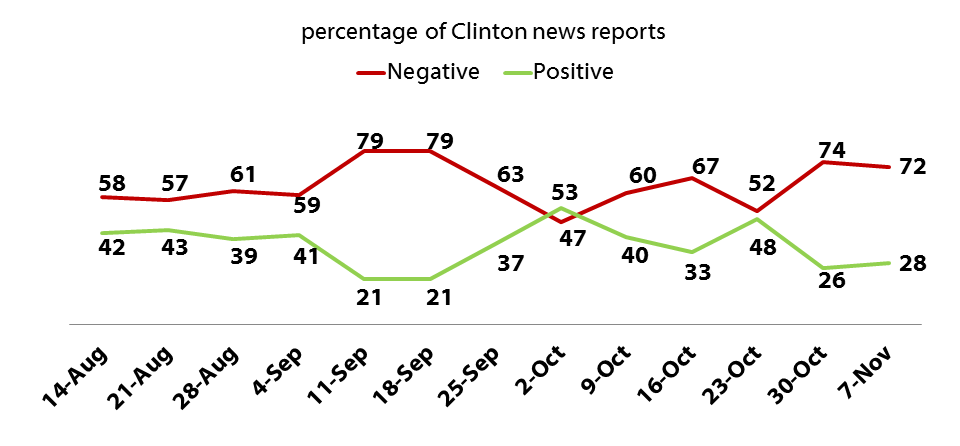
Like Trump, Clinton’s coverage during the general election was unfavorable in all the news outlets in our study (see Figure 13). But the level of negativity varied more widely in her case. In the Los Angeles Times, she came close to ending up in positive territory. The breakdown was 53 percent negative to 47 percent positive. In all other outlets, negative coverage outpaced positive coverage by more than 60-40. Fox News was on the high end, allocating its coverage 81 percent negative to 19 percent positive. The other outlier was The Washington Post where her coverage was 77 percent negative to 23 percent positive.
Figure 13. Tone of Clinton’s Coverage, by News Outlet
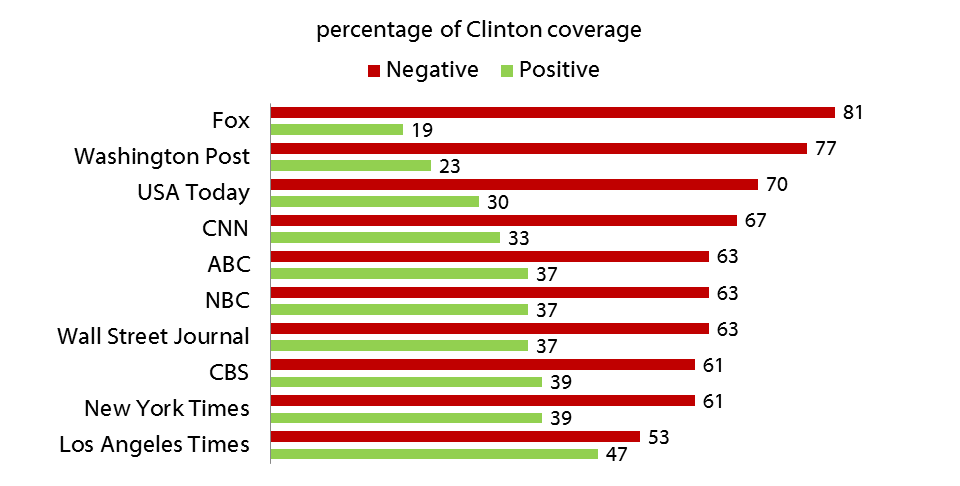
The horserace was the main focus of Clinton’s coverage, accounting for more than two-fifths of her coverage (see Figure 14). Her policy positions received less attention than did Trump’s (9 percent versus 12 percent) and the coverage was less focused. Whereas his position on immigration received considerable attention, she did not have a single policy issue that accounted for more than 1 percent of her coverage. If she had a policy agenda, it was not apparent in the news. Her lengthy record of public service also received scant attention.
Figure 14. Topics of Clinton’s Coverage
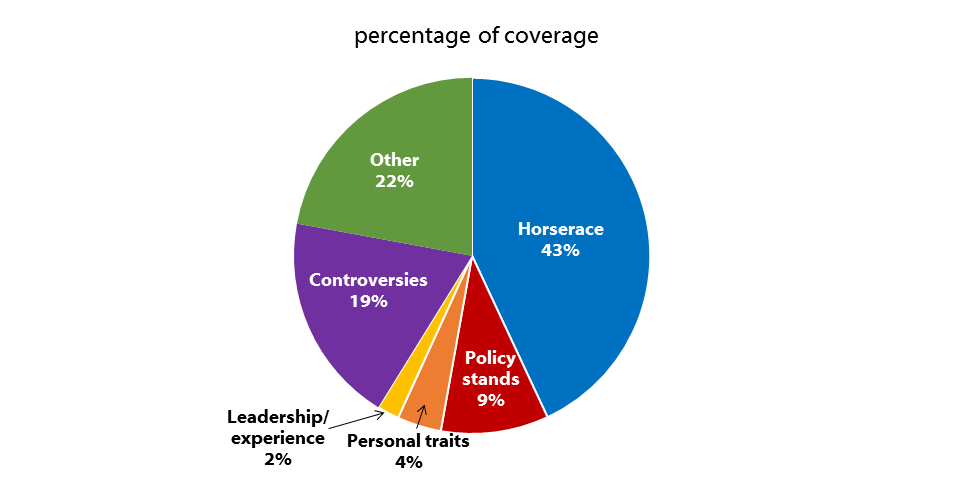
On the other hand, Clinton’s controversies got more attention than Trump’s (19 percent versus 15 percent) and were more focused. Trump wallowed in a cascade of separate controversies. Clinton’s badgering had a laser-like focus. She was alleged to be scandal-prone. Clinton’s alleged scandals accounted for 16 percent of her coverage—four times the amount of press attention paid to Trump’s treatment of women and sixteen times the amount of news coverage given to Clinton’s most heavily covered policy position.
Clinton’s controversies got more attention than Trump’s (19 percent versus 15 percent) and were more focused.
Clinton did have a source of positive press. Her horserace coverage ran in the black—62 percent positive to 38 percent negative. She led Trump in the polls at virtually every stage of the general election, which was a source of positive news. Her performance in the three presidential debates also boosted her horserace coverage (see Figure 15). Polls indicated that viewers thought she had won all three debates, which was duly noted in her news coverage. Her debate performances also swayed some undecided voters, which led to an uptick in her standing in candidate-preference polls, which was an additional source of positive news.
Figure 15. Tone of Debate Coverage
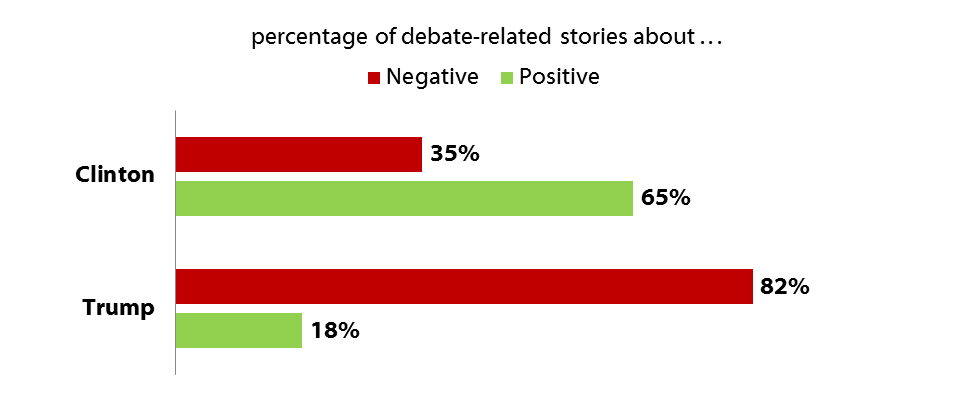
The horserace aside, there wasn’t much in Clinton’s general election news coverage that worked in her favor (see Figure 16). Stories about her personal traits portrayed her as overly cautious and guarded and ran 3-to-1 negative. News reports on her policy positions trended negative by a ratio of 4-to-1. Everything from her position on health care to her position on trade was criticized, often in the form of an attack by Trump or another opponent. Her record of public service, which conceivably should have been a source of positive press, turned out differently. News reports on that topic were 62 percent negative to 38 percent positive, with Trump having a larger voice than she did in defining the meaning of her career. He was widely quoted as saying, “She’s been there 30 years and has nothing to show for it.”
Figure 16. Tone of Clinton’s Coverage, by Topic
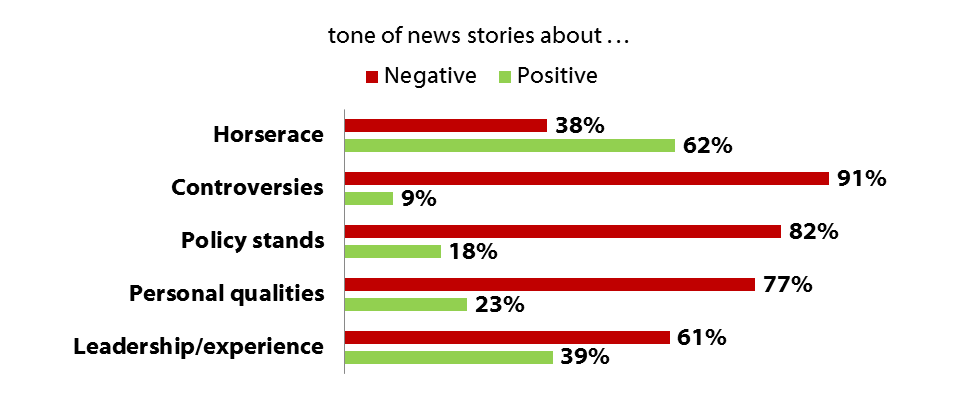
No aspect of Clinton’s coverage, however, was more negative than the controversies that enveloped her campaign. The tone of this coverage was ten times more negative than positive—91 percent to 9 percent. The state of her health was one such controversy. It ran four to one negative over positive. The bulk of the controversies took the form of a “scandal”— emails, Benghazi, ongoing investigations, and the like. News reports on this topic ran 19-to-1 negative over positive. Figure 17 provides an indication of just how fully Clinton’s coverage was fueled by the scandal allegations. There was no week in which the subject accounted for less than 7 percent of her coverage and, in the campaign’s final week, it consumed more than a third of her coverage.
Figure 17. Clinton’s “Scandal” Coverage, by Week
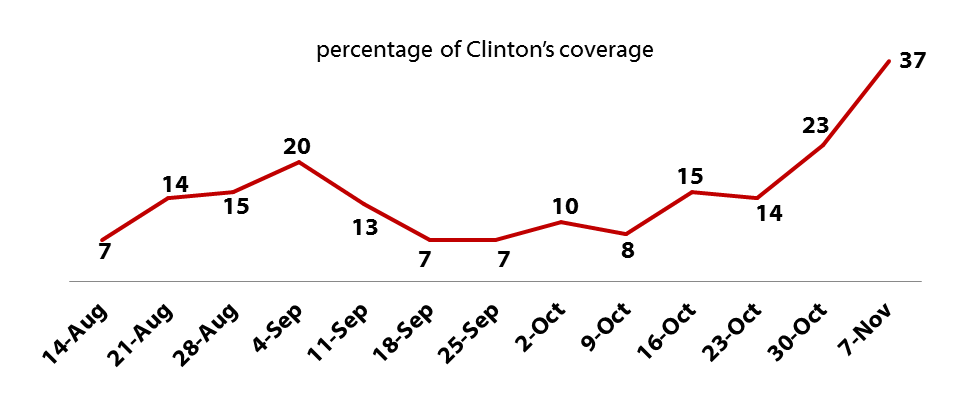
The ten news outlets in our study varied in their attention to the Clinton scandal allegations. The Los Angeles Times gave them the least space—7 percent of its Clinton coverage focused on the scandals. The Los Angeles Times actually gave more news space to Clinton’s policy positions than to the alleged scandals—the only one of the ten outlets to do so. Fox News was at the other extreme, spending 27 percent of its Clinton coverage on the scandals. CNN was second at 18 percent. The cable networks thrive on controversy, and Clinton’s alleged scandals were no exception. All three broadcast networks also played them up. The average for ABC, CBS, and NBC was 16 percent. The average for the newspapers in our study was several points lower (11 percent).
In all ten outlets, the tone of coverage of Clinton’s alleged scandals was highly negative. It equaled or exceeded 95 percent negative in every outlet except NBC, The New York Times, The Wall Street Journal, and The Washington Post. The Post was the least negative—its coverage divided 90 percent negative to 10 percent positive. With the possible exception of the Post, none of the outlets made a concerted effort to put the allegations in context. Was Clinton’s merging of her personal and official emails, which had also been the practice of other top officials, an egregious and possibly disqualifying error of judgment? The question went largely unanswered in the news coverage, as journalists wrote instead on how the email scandal was causing her to lose voter support.
The old journalistic adage that “bad news is good news” has become an imperative. Although the norms of American journalism dissuade reporters from taking sides in partisan debate, there is no rule that says they can’t bash both sides.[21] “With malice toward all” is how scholars Patricia Moy and Michael Pfau characterize today’s journalists.[22]
If everything and everyone is portrayed negatively, there’s a leveling effect that opens the door to charlatans. The press historically has helped citizens recognize the difference between the earnest politician and the pretender. Today’s news coverage blurs the distinction.
News reporting turned sour during the Vietnam and Watergate era and has grown increasingly bitter.[23] Writing in the mid-1990s, the Washington Post’s David Broder felt the press was spinning out of control. “Cynicism is epidemic right now,” he wrote. “It saps people’s confidence in politics and public officials, and it erodes both the standing and standards of journalism. If the assumption is that nothing is on the level, nothing is what it seems, then citizenship becomes a game for fools, and there is no point in trying to stay informed.”[24] Broder’s colleagues weren’t listening. News coverage has become increasingly negative. In the six presidential elections since Broder wrote those words, negative coverage of the presidential nominees has increased by 19 percentage points from its average in the six preceding elections.[25]
Once a practice gets embedded, it’s hard to root out. The incentives in journalism today, everything from getting a story to go viral to acquiring a reputation as a hard-hitting reporter, encourage journalists to engage in criticism and attack. As Kathleen Hall Jamieson put it, journalists have become conditioned to “find the wart [and] make it stand for the whole.”[26] Hyper-criticism has now reached a point where many reporters have difficulty imagining what a constructive form of journalism would look like. As a veteran journalist said recently, “The biggest change I have seen in our business over the last 40 years has been that journalism has slid from skepticism, which should be our natural state, but we have slipped from there toward cynicism. It’s gotten to the point where the toughest story for a…reporter to write about a politician is a positive story.”[27]
To be sure, changes in journalism are not the only reason that campaigns have become more negative. The party polarization that has seeped into American politics during the past three decades has been accompanied by rising levels of partisan attack. But to claim that party polarization explains the media’s negative bent is to ignore the fact that the press’s negativity is not confined to party politics. There’s barely an aspect of public life that is not subject to intense criticism.
A healthy dose of negativity is unquestionably a good thing. There’s a lot of political puffery, ineptitude, and manipulation that needs to be exposed, and journalists would be shirking their duty if they failed to expose it. Yet an incessant stream of criticism has a corrosive effect. It needlessly erodes trust in political leaders and institutions and undermines confidence in government and policy.
Negative news has partisan consequences. Given that journalists bash both sides, it might be thought the impact would be neutral. It’s not. For one thing, indiscriminate criticism has the effect of blurring important distinctions. Were the allegations surrounding Clinton of the same order of magnitude as those surrounding Trump? It’s a question that journalists made no serious effort to answer during the 2016 campaign. They reported all the ugly stuff they could find, and left it to the voters to decide what to make of it. Large numbers of voters concluded that the candidates’ indiscretions were equally disqualifying and made their choice, not on the candidates’ fitness for office, but on less tangible criteria—in some cases out of a belief that wildly unrealistic promises could actually be kept.
False equivalencies abound in today’s reporting. When journalists can’t, or won’t, distinguish between allegations directed at the Trump Foundation and those directed at the Clinton Foundation, there’s something seriously amiss. And false equivalencies are developing on a grand scale as a result of relentlessly negative news. If everything and everyone is portrayed negatively, there’s a leveling effect that opens the door to charlatans. The press historically has helped citizens recognize the difference between the earnest politician and the pretender. Today’s news coverage blurs the distinction.
Indiscriminate criticism also works against the party in power. If voters think everything is bad or going downhill, some of them invariably think that it’s time for a change. In our two-party system, that handicaps the in-party, whether a Republican or Democratic administration. It’s hard for those in power to maintain public support if their policy successes get little note and their shortcomings draw headlines.
In the closing days of the 2016 campaign, the nation’s editorial rooms rang the alarm bell, warning voters not to make the choice that many of them seemed ready to make. It went for naught. The watchdog had lost its bite, as well as the respect of the public it claims to serve.
An irony of the press’s critical tendency is that it helps the right wing. Although conservatives claim that the press has a liberal bias, the media’s persistent criticism of government reinforces the right wing’s anti-government message. For years on end, journalists have told news audiences that political leaders are not to be trusted and that government is inept. And when journalists turn their eye to society, they highlight the problems and not the success stories. The news creates a seedbed of public anger, misperception, and anxiety— sitting there waiting to be tapped by those who have a stake in directing the public’s wrath at government.
It’s ironic, too, that negative news erodes trust in the press, which is now at its lowest level in the history of polling. Watchdog reporting can build confidence in the press, but when journalists condemn most everything they see, they set themselves up to be as credible as the boy who repeatedly cried “wolf.” In the closing days of the 2016 campaign, the nation’s editorial rooms rang the alarm bell, warning voters not to make the choice that many of them seemed ready to make. It went for naught. The watchdog had lost its bite, as well as the respect of the public it claims to serve. In a Pew Research Center survey taken shortly after the November 2016 balloting, only one in five respondents gave the press a grade of “B” or higher for its performance. Four of five graded its performance as a “C” or lower, with half of them giving it an “F.”
[1] “The Last Lap,” Pew Research Center, October 30, 2000. The Pew study found that Gore’s coverage was negative by a balance of 56-13 percent while Bush’s coverage was 49-24 percent negative over positive. When weighted by the amount of campaign coverage devoted to each candidate (29 percent for Gore and 24 percent), the combined average for the two candidates was 75 percent negative to 25 percent positive.
[2] Data are from Roland Schatz, “Divided USA: How Did It Start, and How to Overcome the Stereotypes,” provided to the author by email on October 30, 2016. Data were generated by Media Tenor, which Schatz heads.
[3] Quoted in Thomas Patterson, “More Style Than Substance,” Political Communication and Persuasion 8 (1991): 157.
[4] Farhad Manjoo, “How the Internet Is Loosening Our Grip on the Truth,” New York Times, Nov. 2, 2016. http://www.nytimes.com/2016/11/03/technology/how-the-internet-is-loosening-our-grip-on-the-truth.html
[5] Thomas E. Patterson, “Pre-Primary News Coverage of the 2016 Presidential Race: Trump’s Rise, Sanders’ Emergence, Clinton’s Struggle,” Shorenstein Center on Media, Politics and Public Policy, Kennedy School of Government, Harvard University, June 13, 2016. https://shorensteincenter.org/pre-primary-news-coverage-2016-trump-clinton-sanders/
[6] Thomas E. Patterson, “News Coverage of the 2016 Presidential Primaries: Horse Race Reporting Has Consequences,” Shorenstein Center on Media, Politics and Public Policy, Kennedy School of Government, Harvard University, July 11, 2016. https://shorensteincenter.org/news-coverage-2016-presidential-primaries/
[7] Thomas E. Patterson, “News Coverage of the 2016 National Conventions: Negative News, Lacking Context,” Shorenstein Center on Media, Politics and Public Policy, Kennedy School of Government, Harvard University, September 21, 2016. https://shorensteincenter.org/news-coverage-2016-national-conventions/
[8] Media Tenor has several hundred topic categories that are applied to news reports. The graphs and percentages reported in this paper are based on all categories that received more than 0.5 percent of the coverage.
[9] Everett Carll Ladd, Transformations of the American Party System, 2ed. (New York: Norton, 1978), 194.
[10] According to various accounts, the primary debate audiences ranged upwards of ten million, with the top debate drawing about 23 million. The first presidential general election debate drew more than 80 million viewers while the other two had more than 60 million viewers.
[11] Theodore H. White, The Making of the President 1972 (New York: Bantam, 1973), p. 327.
[12] Bernard C. Cohen, The Press and Foreign Policy (Princeton, N.J.: Princeton University Press, 1963), 13.
[13] See, for example, Shelley Hepworth, Vanessa Gezari, Kyle Pope, Cory Schouten, Carlett Spike, David Uberti and Pete Vernon, “Covering Trump: An oral history of an unforgettable campaign,” Columbia Journalism Review, November 22, 2016. http://www.cjr.org/special_report/trump_media_press_journalists.php
[14] In Media Tenor’s coding, there are two categories that include horserace content but not exclusively. One of the categories is “National Election,” which captures news reports that refer broadly to the election, such as the number of days until election day. The amount of horserace material in that category is relatively small, so it is not included in the horserace category. The other category is “Election Campaign,” which refers to a specific candidate and includes such things as strategy, tactics, staff shakeups, crowd size at events, and targeting of a battleground state. The large majority of reports in this category are about the horserace. In the analysis, 75 percent of the reports in this category were deemed “horserace” and 25 percent were deemed “other.”
[15] See, Thomas Patterson, The Mass Media Election (New York: Praeger, 1980).
[16] The best analysis of this tendency is still, thirty years later, Maura Clancy and Michael Robinson, “General Election Coverage, Part I,” in The Mass Media in Campaign ’84, ed. Michael Robinson and Austin Ranney (Washington, DC: American Enterprise Institute, 1985), 29.
[17] http://www.washingtonpost.com/wp-srv/politics/special/clinton/frenzy/carter.htm
[18] Larry Sabato, Feeding Frenzy: How Attack Journalism Has Transformed American Politics (New York: Free Press, 1991), 1.
[19] Tim Groeling and Samuel Kernell, “Is Network News Coverage of the President Biased?” The Journal of Politics 60 (1998): 1063-1087
[20] Thomas E. Patterson, Out of Order (New York: Knopf, 1993).
[21] Michael Robinson, “Public Affairs Television and the Growth of Political Malaise,” American Political Science Review 70 (1976): 409-432.
[22] Patricia Moy and Michael Pfau, With Malice Toward All? (Westport, CT: Praeger, 2000).
[23] Thomas E. Patterson, The Vanishing Voter (New York: Knopf, 2002), 70.
[24] David Broder, “War on Cynicism,” The Washington Post, July 6, 1994, A19.
[25] See Figure 3 in this paper.
[26] Kathleen Hall Jamieson, Dirty Politics (New York: Oxford University Press, 1992), 215.
[27] Joe Klein, quoted in Peter Hamby, “Did Twitter Kill the Boys on the Bus?” Shorenstein Center on the Media, Politics and Public Policy, Kennedy School of Government, Harvard University, Cambridge, MA., September 2013, p. 93. https://shorensteincenter.org/d80-hamby/

Videos
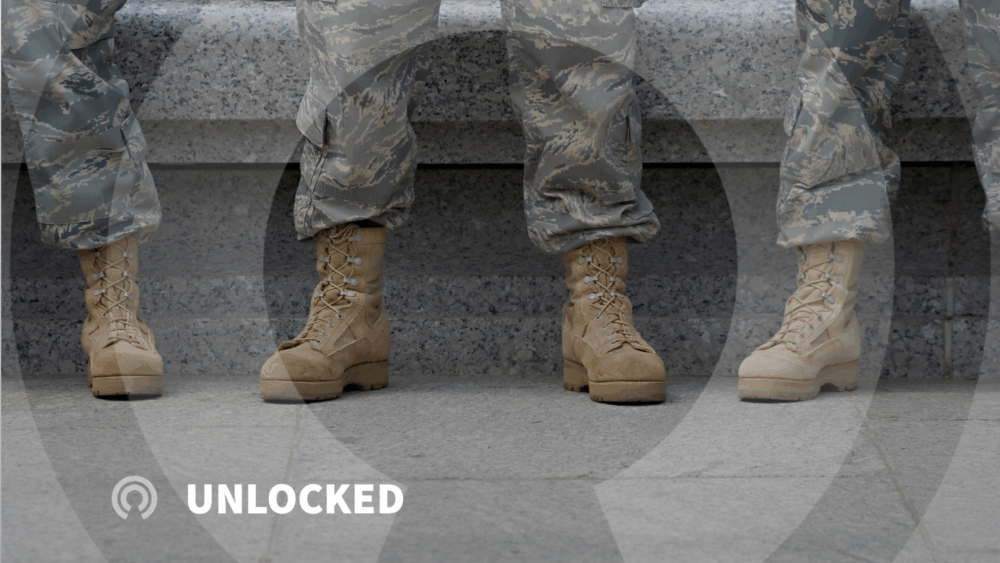
Explainers, Podcasts, Videos
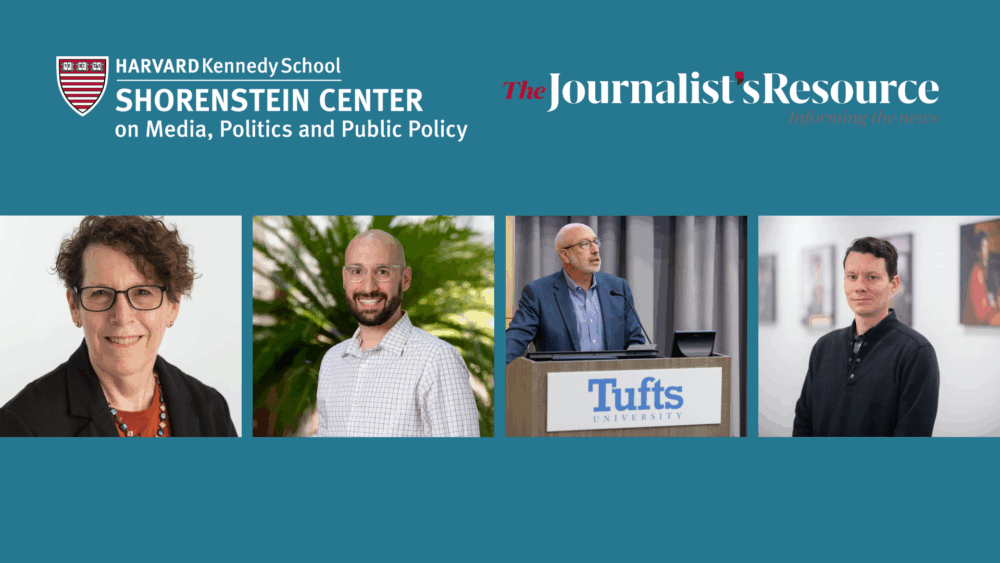
Videos